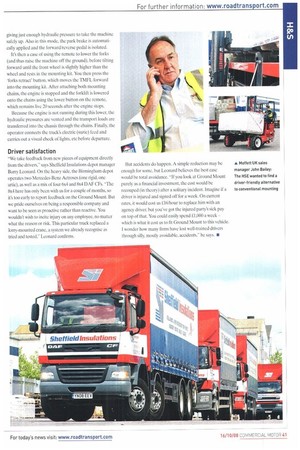The problem with accessing many truckmounted forklifts (TMFL) is usually
Page 38

Page 41

If you've noticed an error in this article please click here to report it so we can fix it.
one of height. When stowed, the position of the TMFL is normally dictated by rear chassis height, the type of mounting kit, and overall ground clearance — not the distance the operator has to climb to work the equipment once it is on the ground. At the moment, the only way to bring the forklift down to terra firma (and back up again) is to climb on and off while it is suspended 1.2m in the air. Imagine if it's raining heavily, the driver is blocking the road and the building site he is delivering to is champing at the bit. All these factors can increase the risk of the driver rushing and being careless, having an accident and then time off work — and the frantic search for a replacement driver.
The height the operator has to climb was highlighted by a Health & Safety Executive (HSE) official when we visited the Moffett stand at the 2006 CV Show. "With an eye on the Working at Height Directive, the HSE wanted to know if it was possible to find an alternative to conventional mounting; without the operator actually climbing on and off," recalls Moffett's UK sales manager John Bailey.
The firm set to work on what we now know as Ground Mount, a system where mounting and dismounting is supervised by a wireless remote control. The process for mounting and dismounting is mirrored, so we'll explain the formen after the obligatory visual checks, the mounting process is quick and can be completed in seconds.
How it works
The operator approaches the rear of the vehicle slowly and squarely with the mast extended and the side-shift control centered. You then drive forward until the forks are engaged between the mounting supports. The steering wheel is then turned to full lock to reduce overhang.
This procedure is the same as a TMFL without Ground Mount. The main difference starts now, as the driver removes the key and leaves the vehicle using Moffett's approved three-point contact method.
With the remote control, the operator then enters the start-up code on the keypad. This fires the engine up in safe-start mode, giving just enough hydraulic pressure to take the machine safely up. Also in this mode, the park brake is automatically applied and the forward/reverse pedal is isolated.
It's then a case of using the remote to lower the forks (and thus raise the machine off the ground), before tilting forward until the front wheel is slightly higher than the wheel and rests in the mounting kit. You then press the 'forks retract' button, which moves the TMFL forward into the mounting kit. After attaching both mounting chains, the engine is stopped and the forklift is lowered onto the chains using the lower button on the remote, which remains live 20 seconds after the engine stops.
Because the engine is not running during this lower, the hydraulic pressures are vented and the transport loads are transferred into the chassis through the chains. Finally, the operator connects the truck's electric (suzie) feed and carries out a visual check of lights, etc before departure.
Driver satisfaction
-We take feedback from new pieces of equipment directly from the drivers," says Sheffield Insulations depot manager Barry Leonard. On the heavy side, the Birmingham depot operates two Mercedes-Benz Actroses (one rigid, one artic), as well as a mix of four 6x4 and 8x4 DAF CFs. -The 8x4 here has only been with us for a couple of months, so it's too early to report feedback on the Ground Mount. But we pride ourselves on being a responsible company and want to be seen as proactive rather than reactive. You wouldn't wish to incite injury on any employee, no matter what the reason or risk. This particular truck replaced a lorry-mounted crane, a system we already recognise as tried and tested,Leonard confirms. But accidents do happen. A simple reduction may be enough for some, but Leonard believes the best case would be total avoidance. "If you look at Ground Mount purely as a financial investment, the cost would be recouped (in theory) after a solitary incident. Imagine if a driver is injured and signed off for a week. On current rates, it would cost us .£16/hour to replace him with an agency driver, but you've got the injured party's sick pay on top of that. You could easily spend £1,000 a week — which is what it cost us to fit Ground Mount to this vehicle. I wonder how many firms have lost well-trained drivers through silly, mostly avoidable, accidents,he says. •
















































































































































































